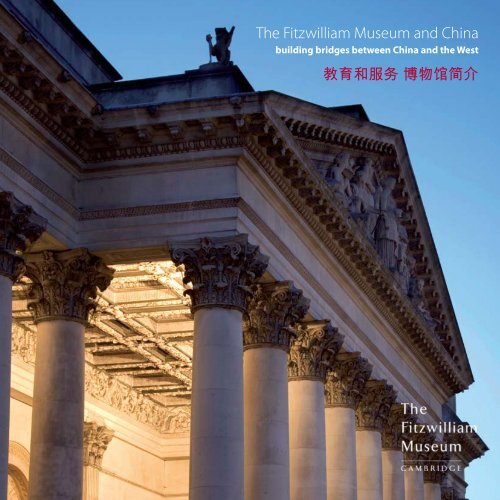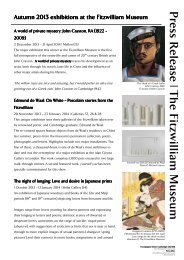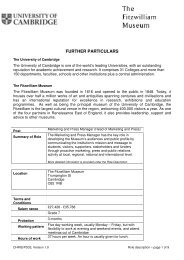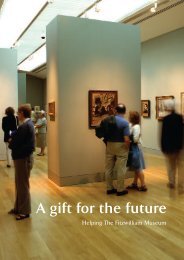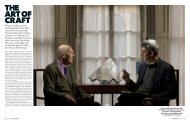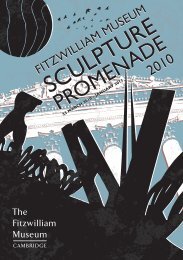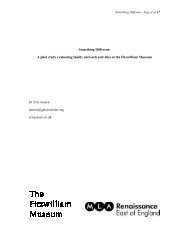The Fitzwilliam Museum and China
The Fitzwilliam Museum and China
The Fitzwilliam Museum and China
Create successful ePaper yourself
Turn your PDF publications into a flip-book with our unique Google optimized e-Paper software.
<strong>The</strong> <strong>Fitzwilliam</strong> <strong>Museum</strong> <strong>and</strong> <strong>China</strong><br />
building bridges between <strong>China</strong> <strong>and</strong> the West
2 | <strong>Fitzwilliam</strong> <strong>Museum</strong>
<strong>The</strong> <strong>Fitzwilliam</strong> <strong>Museum</strong> <strong>and</strong> <strong>China</strong><br />
building bridges between <strong>China</strong> <strong>and</strong> the West
From the Director<br />
<strong>The</strong> <strong>Fitzwilliam</strong> <strong>Museum</strong> is one of Britain’s foremost museums<br />
<strong>and</strong> houses some of the country’s finest collections of art <strong>and</strong><br />
antiquities. It was founded in 1816 by the bequest of Richard,<br />
Viscount <strong>Fitzwilliam</strong>, an 18th century collector <strong>and</strong> art lover<br />
who, at his death, gifted his personal collection of paintings,<br />
prints, books <strong>and</strong> manuscripts “for the increase of learning.” Lord<br />
<strong>Fitzwilliam</strong>’s bequest also provided sufficient funds to erect the<br />
magnificent museum building with its distinctive, neo-classical<br />
facade, which opened to the public in 1848. Its collections<br />
have grown by gift, bequest <strong>and</strong> purchase over nearly 200<br />
years so that the <strong>Museum</strong> is now regarded as “one of the<br />
greatest collections of the nation <strong>and</strong> a monument of the first<br />
importance” <strong>and</strong> as “the finest small museum in Europe”.<br />
Today the <strong>Museum</strong> is privileged to hold more than 500,000<br />
objects representing most of the great civilisations of the past –<br />
from ancient Egypt, the Near East, Greece, Rome <strong>and</strong> <strong>China</strong> <strong>and</strong><br />
including paintings from the fourteenth century to the present<br />
day, drawings, prints, coins <strong>and</strong> medals, rare books, manuscripts<br />
<strong>and</strong> music, sculpture, armour, pottery, glass <strong>and</strong> oriental art. All<br />
the collections have been designated by government as being<br />
of national importance <strong>and</strong> many of the objects attract the<br />
interest <strong>and</strong> attention of international scholars.<br />
4 | <strong>Fitzwilliam</strong> <strong>Museum</strong><br />
<strong>The</strong> <strong>Museum</strong>’s contemporary mission reflects its founder’s<br />
principles <strong>and</strong> his commitment to academic excellence <strong>and</strong><br />
public education, which are pursued by offering permanent<br />
displays, exhibitions <strong>and</strong> public programmes designed to<br />
engage as wide an audience as possible. More than 300,000<br />
visits are made each year by scholars, school children <strong>and</strong><br />
families from the local region, as well as by tourists <strong>and</strong> visitors<br />
from the UK <strong>and</strong> overseas. <strong>The</strong> <strong>Museum</strong> is receives funding<br />
from a variety of sources including Central Government,<br />
research funding bodies, trusts <strong>and</strong> foundations, donations<br />
from individual <strong>and</strong> corporate sponsors <strong>and</strong> the University of<br />
Cambridge. Admission is free <strong>and</strong> will remain so – if we can<br />
maintain <strong>and</strong> increase the level of giving.<br />
This brochure provides a snapshot of some of the <strong>Museum</strong>’s<br />
many wide-ranging activities.<br />
Dr Timothy Potts, Director
University of Cambridge | 5
Research <strong>and</strong> Study<br />
Research <strong>and</strong> teaching form a major part of the <strong>Fitzwilliam</strong><br />
<strong>Museum</strong>’s activity. Its outst<strong>and</strong>ing <strong>and</strong>, in some cases, unique<br />
collections attract scholars from many disciplines from all<br />
over the world <strong>and</strong> present many excellent opportunities for<br />
museum staff to pursue research interests leading to related<br />
exhibitions <strong>and</strong> publications. <strong>The</strong>y also engage in teaching<br />
for the University of Cambridge. Over 2,000 students in higher<br />
education use the museum’s collections each year.<br />
Among the <strong>Museum</strong>’s holdings are outst<strong>and</strong>ing examples<br />
of European painting <strong>and</strong> sculpture, including renowned<br />
masterpieces from the Renaissance to the 20th century.<br />
<strong>The</strong> medieval collections are particularly rich <strong>and</strong> the<br />
subject of large collaborative research projects. <strong>The</strong>se<br />
include a multi-volume catalogue of the Illuminated<br />
Manuscripts held by the <strong>Museum</strong>, the Colleges of the<br />
University of Cambridge <strong>and</strong> the University Library,<br />
coordinated at the <strong>Museum</strong>. A multi-volume survey <strong>and</strong><br />
publication of medieval European coinage, accompanied<br />
by an extensive website is also in preparation.<br />
Undergraduate <strong>and</strong> graduate students in many disciplines,<br />
including oriental studies, classics, history <strong>and</strong> the history of<br />
art, are taught in the museum <strong>and</strong> encouraged to research<br />
the collections. <strong>The</strong> research activity of the curatorial <strong>and</strong><br />
6 | <strong>Fitzwilliam</strong> <strong>Museum</strong><br />
conservation staff results in publications <strong>and</strong> exhibitions –<br />
both in the museum <strong>and</strong> online - that throws fresh light on<br />
their subjects <strong>and</strong> excites the interest of both academic <strong>and</strong><br />
general visitors.<br />
<strong>The</strong> study of the Chinese collections is led by Dr James C. S.<br />
Lin, a leading academic expert who specialises in jades <strong>and</strong><br />
the Han Dynasties. He curated the recent exhibition <strong>The</strong><br />
Immortal Stone: Chinese jades from the Neolithic period to the<br />
twentieth century <strong>and</strong> authored the accompanying catalogue.<br />
Dr Lin, who is affiliated to the Department of East Asian Studies<br />
within the Faculty of Asian <strong>and</strong> Middle Eastern Studies of the<br />
University of Cambridge, supervises students from Tsinghua<br />
University, <strong>and</strong> hosts visitors <strong>and</strong> scholars from the PRC <strong>and</strong><br />
Hong Kong, on a regular basis.
University of Cambridge | 7
Exhibitions<br />
<strong>The</strong> <strong>Museum</strong> has a strong history of organising major<br />
exhibitions, many of them centred on the <strong>Fitzwilliam</strong>’s own<br />
collections, including <strong>The</strong> Cambridge Illuminations (2005)<br />
illuminated manuscript treasures from the <strong>Museum</strong>, 18<br />
Cambridge Colleges <strong>and</strong> the University Library; ‘I Turned it<br />
into a Palace’, Sir Sydney Cockerell <strong>and</strong> the <strong>Fitzwilliam</strong> <strong>Museum</strong><br />
(2008), celebrating the centenary of the appointment of the<br />
<strong>Museum</strong>’s most important director to date; <strong>The</strong> Immortal Stone:<br />
Chinese jades from the Neolithic period to the twentieth century<br />
(2008/09) <strong>and</strong> many more.<br />
Increasingly, the <strong>Museum</strong> is mounting important international<br />
exhibitions in collaboration with major international partners.<br />
In 2008 it presented the UK’s only opportunity to see stunning<br />
ancient goldwork in From the L<strong>and</strong> of the Golden Fleece, tomb<br />
treasures from Ancient Georgia, organised in collaboration with<br />
the Institute for the Study of the Ancient World, New York<br />
University.<br />
In 2009, to commemorate the 200th anniversary of the birth of<br />
Charles Darwin, the <strong>Museum</strong> organised Endless Forms: Charles<br />
Darwin, Natural Science <strong>and</strong> the Visual Arts in collaboration with<br />
the Yale Center for British Art, New Haven, USA. It opened at<br />
the <strong>Fitzwilliam</strong> <strong>Museum</strong> to ecstatic reviews <strong>and</strong> enthusiastic,<br />
8 | <strong>Fitzwilliam</strong> <strong>Museum</strong><br />
record breaking audiences. <strong>The</strong> exhibition broke new ground<br />
for the <strong>Museum</strong> <strong>and</strong> demonstrates its determination <strong>and</strong><br />
ability to stimulate dialogue <strong>and</strong> new connections across<br />
academic disciplines in both the arts <strong>and</strong> sciences.<br />
In 2012 the <strong>Museum</strong> plans the first <strong>and</strong> largest exhibition of<br />
Western Han treasures outside <strong>China</strong> (see below).<br />
“Curatorial genius…best show of the year” <strong>The</strong> Daily Telegraph<br />
“A major achievement” New York Times
“Superb” <strong>The</strong> Daily Telegraph<br />
University of Cambridge | 9
Education & Outreach<br />
<strong>The</strong> <strong>Museum</strong> is a natural focus for teaching <strong>and</strong> outreach. It has<br />
been committed to public engagement since it opened over<br />
160 years ago. Its education programmes for adults <strong>and</strong> young<br />
people reach wider audiences every year. In 2009–10 more<br />
than 23,000 school children took part in inspiring activities<br />
based on the collections <strong>and</strong> exhibitions, <strong>and</strong> spanning the<br />
school curriculum, led by the museum’s educators:<br />
“H<strong>and</strong> on heart I can say that every single child has raised their game,<br />
has benefited from this. <strong>The</strong>re’s not one child in all of the classes that<br />
I’ve brought to the <strong>Fitzwilliam</strong> who hasn’t benefited. That’s a fantastic<br />
thing to say about an education project”.<br />
10 | <strong>Fitzwilliam</strong> <strong>Museum</strong><br />
Teacher, St Mary’s C of E Primary School<br />
“it is so stimulating for them. <strong>The</strong>y go back to school with such ideas<br />
<strong>and</strong> enthusiasm”.<br />
Teacher, year 5, Orchard Primary School<br />
A similar number of young people come with their classroom<br />
teachers, in visiting overseas groups or independently.<br />
Each major exhibition is accompanied by a programme of<br />
public lectures <strong>and</strong> talks by leading experts, many drawn from<br />
the University’s academic community.<br />
Some thous<strong>and</strong>s of adults, members of the general public,<br />
take part in lectures, talks, workshops <strong>and</strong> courses about the<br />
collections <strong>and</strong> exhibitions every year. In 2010 over 1500<br />
people joined in an Outdoor Festival of Chinese Culture.<br />
Festival of Chinese culture 2010
Online presence<br />
<strong>The</strong> <strong>Museum</strong> has an unusually rich <strong>and</strong> extensive website<br />
where records of more than 165,000 objects, together<br />
with virtual exhibitions, publications, learning resources for<br />
teachers, information about the activities of the curatorial <strong>and</strong><br />
conservation departments, podcasts <strong>and</strong> interactives, take the<br />
<strong>Museum</strong>’s collections <strong>and</strong> activities to a world-wide audience.<br />
http://www.fitzmuseum.cam.ac.uk<br />
Young musician entertains guests at the launch of<br />
Eastern Exchanges, part of the Cultural Olympiad, 2010<br />
University of Cambridge | 11
Engagement with <strong>China</strong><br />
<strong>The</strong> <strong>Fitzwilliam</strong> <strong>Museum</strong> houses one of the most extensive<br />
collections of Chinese objects in the UK. Most of the 200<br />
Chinese jade <strong>and</strong> hard stone objects arrived in the early<br />
twentieth century when the building of the railways in<br />
<strong>China</strong> yielded many archaeological discoveries <strong>and</strong> Western<br />
connoisseurs began to collect Chinese artefacts. <strong>The</strong><br />
collections also include examples of snuff bottles, porcelain<br />
vessels, gold, silver <strong>and</strong> bronze objects, lacquer-ware, ivories<br />
<strong>and</strong> enamels.<br />
<strong>The</strong> <strong>Museum</strong> has been cultivating the use of its Chinese<br />
collections for some years. In partnership with ‘<strong>China</strong> Now’, an<br />
organisation to promote greater underst<strong>and</strong>ing of <strong>China</strong> in<br />
the UK, <strong>and</strong> to mark the Beijing Olympics (2008), we mounted<br />
a small exhibition Made for Export: Chinese nineteenth century<br />
flower drawings (2008), showing works which mark the growing<br />
interest in Britain in Chinese horticulture. <strong>The</strong> exhibition also<br />
included an album by Youqua, made in Canton (Guangzhou),<br />
showing tea cultivation, <strong>and</strong> a scroll describing sericulture.<br />
12 | <strong>Fitzwilliam</strong> <strong>Museum</strong><br />
Attributed to Qiu Ying, <strong>The</strong> making of silk, 18th century<br />
<strong>The</strong> display of porcelain made in <strong>China</strong> for export alongside<br />
English <strong>and</strong> European porcelain made in imitation or<br />
influenced by Chinese designs is a feature of our permanent<br />
displays, <strong>and</strong> has been of great interest to European <strong>and</strong><br />
Chinese scholars. We are hoping to send a range of such<br />
objects on loan to Tsinghua University <strong>and</strong> Hong Kong.
University of Cambridge | 13
Exhibition 2012<br />
Royal Treasures of Han <strong>China</strong><br />
<strong>The</strong> <strong>Fitzwilliam</strong> <strong>Museum</strong>, together with other museums<br />
in the East of Engl<strong>and</strong>, has developed a plan to foster<br />
underst<strong>and</strong>ing of <strong>China</strong>’s cultural heritage <strong>and</strong> achievements.<br />
<strong>The</strong> programme, called Eastern Exchanges, has been endorsed<br />
as a major project in Stories of the World, UK museums’<br />
contribution to the Cultural Olympiad for the London 2012<br />
Olympic <strong>and</strong> Paralympic Games. In early 2010 the <strong>Fitzwilliam</strong><br />
<strong>Museum</strong> hosted a residency of the Chinese artist Chen Hong,<br />
the well-known ‘Fish King’, <strong>and</strong> co-ordinated his visits to other<br />
museums in the region. Over 2,500 adults <strong>and</strong> children took<br />
part in activities or watched demonstrations by this Chinese<br />
master. In 2011 a UK artist will spend two months in <strong>China</strong><br />
<strong>and</strong> further cultural exchanges will be encouraged in the<br />
lead up to the Olympic Games.<br />
14 | <strong>Fitzwilliam</strong> <strong>Museum</strong><br />
In Cambridge, the climax of all these activities will, we hope, be<br />
the staging of the most important exhibition of Han cultural<br />
material ever seen outside the People’s Republic of <strong>China</strong>.<br />
<strong>The</strong> exhibition, Tomb Treasures of Han <strong>China</strong>, is planned to<br />
run for six months from April-September 2012. It presents an<br />
unprecedented opportunity to highlight Han Chinese culture, art,<br />
religious beliefs <strong>and</strong> daily life through the spectacular discoveries<br />
in the tombs of the Western Han Period (206BC–8AD).<br />
<strong>The</strong> exhibition initiative has been a major priority for the<br />
<strong>Museum</strong>. Director Dr. Timothy Potts describes the project as<br />
‘an internationally significant milestone in British museums’<br />
engagement with <strong>China</strong>, <strong>and</strong> of the first importance in<br />
promoting wider underst<strong>and</strong>inng of a critical period of Chinese<br />
history whose legacy continues to shape modern <strong>China</strong>’s identity’.
University of Cambridge | 15
Building bridges<br />
In addition to being groundbreaking <strong>and</strong> visually stunning,<br />
Tomb Treasures of Han <strong>China</strong> will present an opportunity for<br />
major cultural exchange to take place <strong>and</strong> will provide a<br />
focus for cooperation on research <strong>and</strong> study at the highest<br />
international level. <strong>The</strong> exhibition will be accompanied by<br />
a fully illustrated scholarly catalogue, symposia, lectures <strong>and</strong><br />
talks for both academic <strong>and</strong> general audiences.<br />
A wide-ranging national promotional campaign <strong>and</strong> internet<br />
marketing activity will give the exhibition maximum exposure<br />
<strong>and</strong> it is certain to draw upon London audiences for the<br />
Olympic Games as well national <strong>and</strong> international tourist<br />
visitors to Cambridge (4 million tourists annually), many from<br />
Europe <strong>and</strong> the USA.<br />
<strong>The</strong> <strong>Fitzwilliam</strong> <strong>Museum</strong>, located in the centre of the<br />
historic city of Cambridge, home not only to the University<br />
of Cambridge but also to the largest technology cluster<br />
in Europe, is uniquely placed to ensure not only that the<br />
exhibition becomes a major cultural attraction, but presents<br />
an opportunity to raise <strong>China</strong>’s profile within the UK business<br />
community with the potential to generate new partnerships.<br />
We welcome initiatives supporting artistic activities, events<br />
<strong>and</strong> performances which will enhance our plans for this<br />
historic exhibition project.<br />
16 | <strong>Fitzwilliam</strong> <strong>Museum</strong>
University of Cambridge | 17
Design & print management: H2 Associates, Cambridge
University of Cambridge | 19
© Text <strong>and</strong> images <strong>The</strong> <strong>Fitzwilliam</strong> <strong>Museum</strong>, 2010


